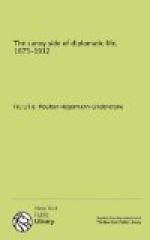[Illustration:
A NOTE FROM MASSENET
This was a reply to a letter of introduction which
Madame de
Hegermann-Lindencrone had written Miss Geraldine Farrar
to
Massenet. He taught her subsequently Manon.]
The Princess desired to meet President Faure for some reason, and, as she could not do that In her father’s house, she desired us to arrange a meeting on the neutral ground of the Legation. On the day fixed they met here In the afternoon. I remained out of the salon, and only returned when the tea-table was brought in. The President partook of his tea with graceful nonchalance.
PARIS, 1897.
Dear L.,—You ask, “What are you doing?” If you had asked what are we not doing I would have told you, but what we are doing covers acres of ground. We are in a whirlwind of duties and pleasures, dinners, soirees, and balls. It would bore you to death to hear about them. Many of my old friends are still in Paris; those you knew are Countess Pourtales (just become a widow); Marquise Gallifet, who is more separated from her husband than ever. She remains Faubourgeoise St.-Germain, and he favors the Republic.
I find Christine Nillson here. From Madame Riviere she has become Countess Casa-Miranda. She has a pretty little hotel near us, where she sings not, “neither does she spin.” I meet her at dear old Mrs. Pell’s Sunday-afternoon ladies’ teas. Nillson and I are the youngest members of the club. You may imagine what the others must be in the way of years. Mrs. Pell gives us each (we are twelve) a gold locket with a teacup engraved on its back, and a lock of her once brown hair inside, and we assemble and eat American goodies made in an ultra-superior manner by her chef.
Our occupations or amusements depend very much upon whom we are with. A whole army of doctors has just descended on us, and we are doing the medical side of Paris. One day we went to see Dr. Doyen, the celebrated cutter-up of men. He said that operations other doctors spent an hour over he did in ten minutes. It sounds a little boastful, but after what I saw I am sure that it is true. He has a very large hospital where he preaches and practises and gives cinematographic representations of his most famous operations. It was very interesting, because at the same time that we were looking at him in the pictures he was sitting behind us explaining things. Strange to say that one or two of the doctors with us fainted away. The ladies did not faint, neither did they look on. The operation which took the most time was the cutting apart of the little Indian twins, Radica and Dodica. This last one (poor little sickly thing) was dying of tuberculosis, and the question was whether the well one should be separated or die with her sister. While this was going on the little survivor came to the door and begged to be let in (she was tired of running up and down the corridor); therefore we knew that the operation had succeeded, which helped to make it less painful to witness.




